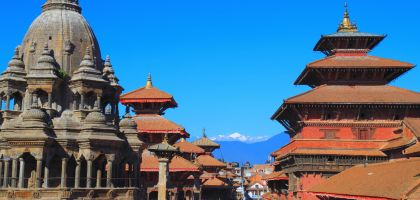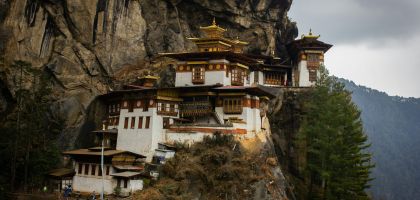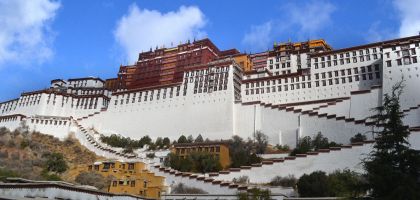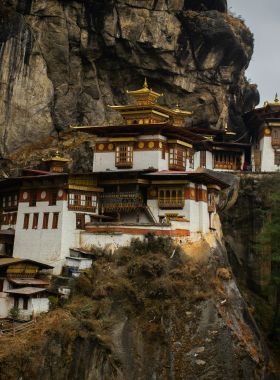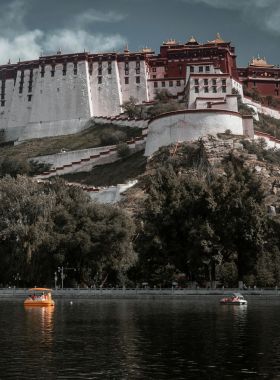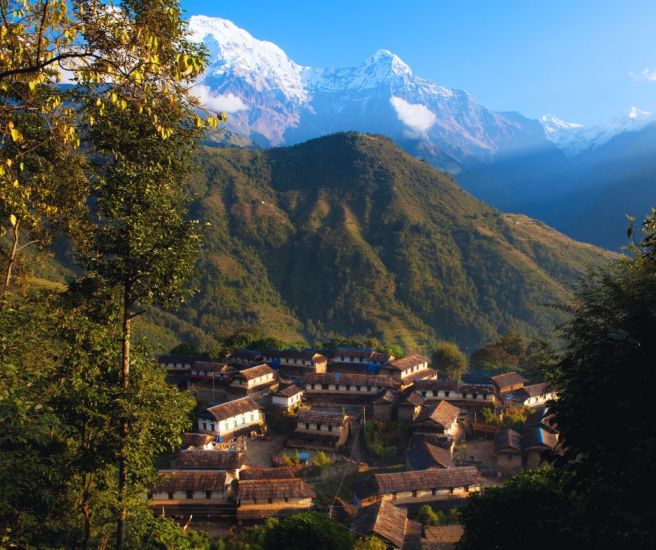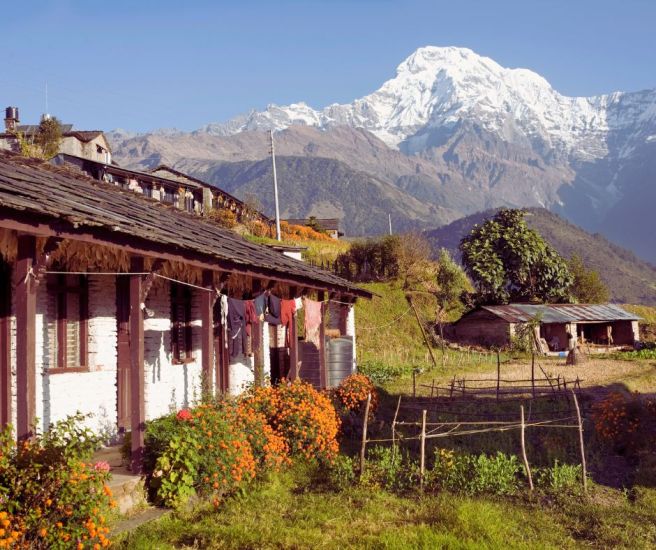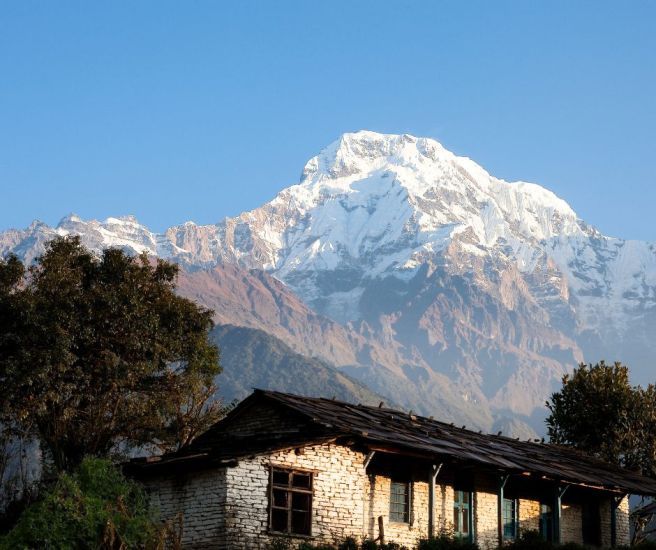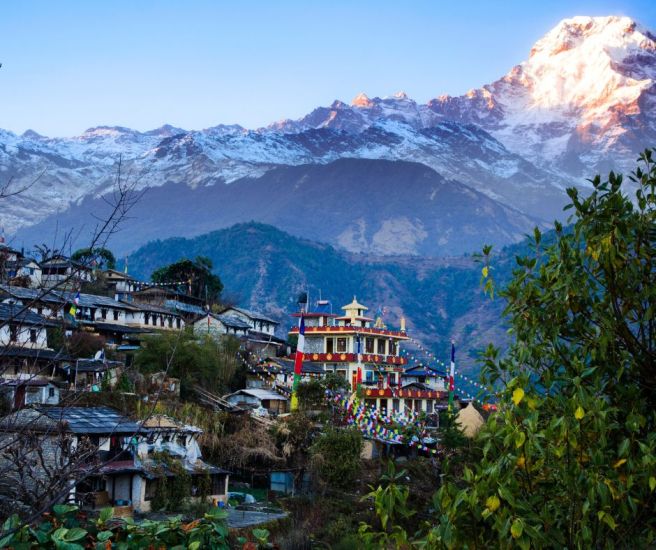Ghandruk Village Trek
4 Days / Nepal
Activity
Difficulty Level
Destinations
Trip Start / End
Max Altitude
Accommodation
Travel Style
Personalized Travel Advice

Dev Raj Nepal
+977 9851096523
Detailed Itinerary
01
DAY
01
Start early from Pokhara in a private vehicle with your crew, heading towards either New Bridge or Phedi. The trail begins with a steep uphill climb towards Dhampus, offering stunning views of Annapurna and Manaslu. If the route takes you through Birethati, cross the Modi River, then turn right to begin the ascent to Ghandruk. This is a 5-hour steep climb, and along the way, you’ll be greeted with breathtaking views of Machhapuchhre (Fishtail) and Annapurna South.
Pokhara to Ghandruk
Start early from Pokhara in a private vehicle with your crew, heading towards either New Bridge or Phedi. The trail begins with a steep uphill climb towards Dhampus, offering stunning views of Annapurna and Manaslu. If the route takes you through Birethati, cross the Modi River, then turn right to begin the ascent to Ghandruk. This is a 5-hour steep climb, and along the way, you’ll be greeted with breathtaking views of Machhapuchhre (Fishtail) and Annapurna South.
02
DAY
02
Ghandruk, the second-largest Gurung village in the Annapurna region, is a fascinating stop. The village offers an authentic glimpse into the life of the Gurung people. You will also have the chance to visit the nearby Gairi Goun, another traditional Gurung village known for its neat slate-roofed houses and intricate network of terraces. Gairi Gaun is nestled on a canyon wall, surrounded by terraced fields where wheat and barley are cultivated. This day offers a wonderful opportunity to experience the lifestyle and culture of the local communities.
Explore Ghandruk Village
Ghandruk, the second-largest Gurung village in the Annapurna region, is a fascinating stop. The village offers an authentic glimpse into the life of the Gurung people. You will also have the chance to visit the nearby Gairi Goun, another traditional Gurung village known for its neat slate-roofed houses and intricate network of terraces. Gairi Gaun is nestled on a canyon wall, surrounded by terraced fields where wheat and barley are cultivated. This day offers a wonderful opportunity to experience the lifestyle and culture of the local communities.
03
DAY
03
Today’s trek involves a series of ascents and descents. You will first descend to the Modi Khola and then climb up to Landruk village. After passing through lush paddy fields, continue with a steep uphill climb towards Pothana, passing through Deuralli Village along the way. The landscape offers impressive views of the surrounding mountains and valleys, making this section of the trek especially rewarding.
Ghandruk to Pothana
Today’s trek involves a series of ascents and descents. You will first descend to the Modi Khola and then climb up to Landruk village. After passing through lush paddy fields, continue with a steep uphill climb towards Pothana, passing through Deuralli Village along the way. The landscape offers impressive views of the surrounding mountains and valleys, making this section of the trek especially rewarding.
04
DAY
04
Begin your final day’s trek from Pothana, a ridge-top village offering panoramic views of the Annapurna range. As you walk along the ridge of a forested hill, the backdrop of majestic mountain views is unforgettable. The descent takes you through Dhampus, eventually reaching Phedi. From there, a short drive brings you back to Pokhara, where you can relax and reflect on the adventure.
Pothana to Pokhara
Begin your final day’s trek from Pothana, a ridge-top village offering panoramic views of the Annapurna range. As you walk along the ridge of a forested hill, the backdrop of majestic mountain views is unforgettable. The descent takes you through Dhampus, eventually reaching Phedi. From there, a short drive brings you back to Pokhara, where you can relax and reflect on the adventure.
Includes / Excludes
Inclusions
-
Trekking permits.
-
Guesthouse accommodations.
-
Transportation to trail head and return transportation from finish point.
-
3 meals a day.
-
English speaking licensed Trekking Guide.
-
1 porter.
-
On camping option, all camping gears, kitchen utensils, food supplies, pack animals, Sherpas are included.
Exclusions
-
Accommodation in Pokhara.
-
Transportation to and return from Pokhara.
-
Drinks, tip and other expenses of personal nature.
-
Extra expenses caused due to nature and unforeseen events.
-
Travel Insurance.
Trip Info
The best time to do the Ghandruk Village Trek is during the pre-monsoon and post-monsoon seasons, which are:
Spring (March to May): This is one of the most popular times for trekking in Nepal. The weather is generally clear, and the rhododendron forests along the trail bloom in vibrant colors, adding a magical touch to the landscape. The temperatures are mild, making for a pleasant trekking experience.
Autumn (September to November): This is another prime season for the Ghandruk Village Trek. The weather is dry and stable, with clear skies offering stunning views of the Annapurna range. The temperatures are cool, especially at higher altitudes, but the conditions are perfect for trekking in the Himalayas.
While Winter (December to February) and Summer (June to August) are less ideal due to colder temperatures and the monsoon season, the trek is still possible with the right preparation. However, spring and autumn remain the best times to enjoy the trek’s natural beauty and panoramic mountain views.
Throughout the trip, private vehicles will be used for transfers and sightseeing. These include comfortable cars or SUVs, which are good for navigating both urban and rural areas. These vehicles are chosen for their comfort and reliability, ensuring a smooth and enjoyable journey between destinations. They are equipped to handle various road conditions and provide a high level of convenience for travelers.
Food on the Ghandruk Village Trek offers a delightful mix of traditional Nepali and Tibetan cuisine, providing trekkers with local flavors and ingredients. Dal Bhat, a hearty and nutritious meal consisting of rice, lentil soup, and vegetables, is a staple in Nepali trekking cuisine and is often served multiple times a day. It’s usually accompanied by a side of pickle for extra flavor. Momo, steamed or fried dumplings filled with meat or vegetables, are a popular snack or lunch option along the trail. For breakfast, Tibetan bread, a type of flatbread served with butter or jam, is commonly enjoyed, providing energy for the day ahead. Warm soups, such as vegetable soup, noodle soup, or thukpa (a Tibetan noodle soup), are common, offering comfort and warmth, especially in the colder regions.
The primary lodging options during the Ghandruk Village Trek are teahouse lodges and guesthouses, which provide a warm and welcoming stay in a picturesque mountain setting.
Teahouse lodges in Ghandruk are family-run establishments that cater to trekkers in this region seeking a comfortable yet authentic experience. These lodges offer both private rooms and shared dormitory-style accommodations. While dormitories typically come with shared bathrooms, some private rooms may include attached facilities. Each room is simple but well-kept, furnished with a bed, mattress, blanket, and pillow. Though the lodges maintain cleanliness, bringing a sleeping bag is advisable, especially during the colder months, to ensure extra warmth and comfort.
Staying in a teahouse lodge not only provides a restful night’s sleep but also offers an opportunity to experience the warm hospitality of the Gurung community, enjoy home-cooked meals, and immerse yourself in the breathtaking mountain scenery.
Clothing & Footwear
- Waterproof and breathable jacket and pants
- Insulating layers (fleece, down jacket)
- Thermal base layers
- Hiking pants and shorts
- Warm hat and sun hat
- Gloves
- Warm socks
- Sturdy, waterproof hiking boots
- Comfortable sandals or shoes
Gear & Accessories
- Backpack (50-70 liters)
- Sleeping bag (rated for cold temperatures)
- Trekking poles
- Headlamp with extra batteries
- Sunglasses
- Sunscreen and lip balm
- Water bottles or hydration system
- Water purification tablets or filter
- Toiletries
- Quick-dry towel
Remember to pack light and efficiently.
Risks
Steep Climbs and Physical Demand
Although the trek is considered moderate, certain sections involve steep ascents and descents, especially the climb to Ghandruk and the descent to Modi Khola. Trekkers who are not accustomed to hiking may find these stretches challenging. Proper pacing and short breaks are essential to avoid fatigue.
Variable Weather Conditions
The weather in the Annapurna region can be unpredictable, even in peak trekking seasons. Sudden rain showers, cold nights, and fog can affect visibility and overall comfort. Those trekking in the winter months should be prepared for chilly temperatures, while monsoon season (June to September) brings slippery trails and leeches. Checking the weather forecast before starting the trek is highly recommended.
Slippery and Uneven Trails
Some sections of the trail, especially the stone steps leading to Ghandruk and the downhill paths towards Modi Khola, can become slippery after rain. Trekkers should wear sturdy hiking boots with good grip and be cautious while descending. Trekking poles can provide additional stability on uneven terrain. Common trekking-related injuries such as blisters, knee pain, or sprains can occur, particularly during prolonged descents. Proper footwear, stretching exercises before the trek, and a slow, steady pace can help minimize the risk of discomfort or injury.
Basic Accommodations and Facilities
While teahouses provide a comfortable stay, they are basic in nature, with limited amenities such as shared bathrooms, simple bedding, and occasional electricity shortages. Hot showers often come at an extra cost, and Wi-Fi availability is minimal. Trekkers should adjust expectations and embrace the simplicity of mountain life.
Breathtaking Mountain Views
One of the most rewarding aspects of the Ghandruk Village Trek is the stunning Himalayan scenery. Trekkers are treated to panoramic views of Annapurna South, Machhapuchhre (Fishtail), Hiunchuli, and other snow-capped peaks. The changing light throughout the day, especially during sunrise and sunset, enhances the beauty of these mountains, creating a truly mesmerizing experience.
Rich Cultural Experience
Ghandruk is a major settlement of the Gurung people, known for their deep-rooted traditions, hospitality, and military history as part of the British and Indian Gurkha regiments. The village showcases traditional stone houses with slate roofs, beautifully preserved cultural practices, and folk music. Trekkers have the opportunity to visit the Gurung Museum, observe daily life, and interact with local families to gain a deeper understanding of their way of life.
Moderate and Accessible Trek
Unlike high-altitude treks that require extensive acclimatization, the Ghandruk trek remains below 2,000 meters, making it a comfortable option for most travelers. The trek is shorter and less physically demanding than other routes in the Annapurna region, yet it still offers rewarding landscapes and cultural immersion. This makes it ideal for beginners, families, and those with limited time.
Scenic and Varied Landscapes
The trek takes travelers through a diverse range of environments, from dense rhododendron forests and terraced fields to deep river valleys and high ridgelines. The contrast between lush green hills, golden fields, and the stark white peaks in the distance makes for a visually stunning experience. During the right season, rhododendrons bloom in vivid reds and pinks, adding even more charm to the journey.
Opportunity for Relaxation and Reflection
Beyond its physical and cultural rewards, the Ghandruk trek offers a sense of peace and solitude. Villages such as Pothana and Dhampus provide quiet, scenic settings where trekkers can reflect on their journey while enjoying the tranquil beauty of the mountains. At Jhinu Danda, an optional stop, natural hot springs provide a soothing way to relax after a day of trekking.
Warm Hospitality and Teahouse Experience
Staying in local teahouses offers a unique experience of traditional Nepali hospitality. These family-run lodges provide simple yet comfortable accommodations, home-cooked meals, and a chance to engage in conversations with both the hosts and fellow trekkers. The warmth of the people adds a personal touch to the adventure, making it more memorable.
A Taste of the Annapurna Region Without a Long Trek
Many travelers wish to experience trekking in the Annapurna region but may not have the time or endurance for longer treks like the Annapurna Base Camp or Circuit Trek. The Ghandruk trek serves as a perfect alternative, offering a condensed yet fulfilling experience of Nepali village life, mountain views, and trekking culture in just a few days.
Altitude and Weather Conditions
The trek remains at a relatively low altitude, with Ghandruk at 1,982 meters (6,503 feet) and Pothana at 1,890 meters (6,200 feet). Altitude sickness is rarely a concern, but some trekkers may experience mild shortness of breath due to the uphill sections. The weather varies by season—spring (March–May) and autumn (September–November) offer the best conditions, with clear skies and comfortable temperatures. Winter trekking can be cold, especially at night, and in summer, rain showers are frequent, making the trails wet and leech-infested in forested areas.
Scenic Views and Natural Beauty
Trekkers are rewarded with breathtaking views of Annapurna South, Machhapuchhre (Fishtail), Hiunchuli, and other Himalayan peaks. The landscapes change dramatically along the route, from dense rhododendron forests and bamboo groves to open ridgelines and terraced fields. In spring, the trails are adorned with blooming rhododendrons, while autumn provides the clearest mountain views.
Gurung Culture and Village Life
Ghandruk is a traditional Gurung village, known for its slate-roofed houses, stone-paved alleys, and rich cultural heritage. The village offers an authentic look into Gurung customs, traditions, and daily life. Visitors can explore the Gurung Museum, interact with locals, and experience traditional Gurung hospitality. The surrounding villages, such as Gairi Gaun and Landruk, provide additional cultural insights, showcasing age-old farming techniques and terrace cultivation.
Trek Difficulty and Physical Requirements
The Ghandruk trek is classified as moderate, requiring a basic level of fitness. While no prior trekking experience is necessary, the uphill climbs and long descents can be tiring. Trekkers should be prepared for 5–6 hours of walking per day, with a mix of steep ascents, gradual inclines, and stone steps. Carrying a daypack with essentials like water, snacks, and rain gear is recommended.
Connectivity and Facilities
Electricity is available in most teahouses, but charging electronics may come at an extra cost. Some lodges offer Wi-Fi, though the connection is often weak or unreliable. Mobile network coverage varies, with better connectivity in lower regions and weaker signals in remote areas. Hot showers are available but may require an additional fee, especially at higher elevations.
Wildlife and Flora
The trail passes through the Annapurna Conservation Area, home to a variety of wildlife and plant species. Trekkers may spot langurs (monkeys), Himalayan pheasants (Nepal’s national bird), barking deer, and a range of butterflies. The forests are filled with oak, rhododendron, and bamboo, creating a vibrant trekking environment. In spring, rhododendron forests burst into shades of red, pink, and white, making for a picturesque journey.
FAQs
Personalized Travel Advice

Dev Raj Nepal
+977 9851096523
